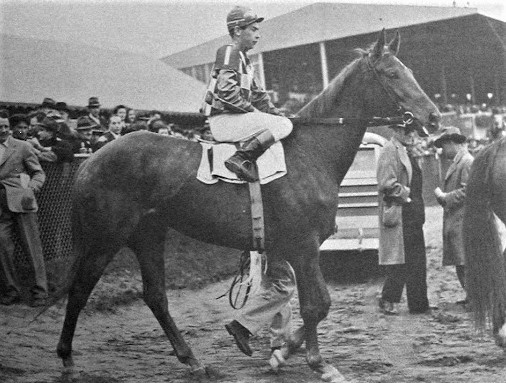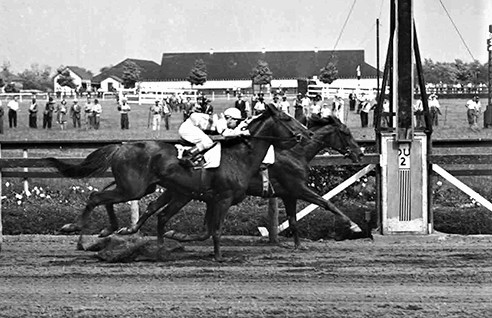
There is good reason the memory of Hall of Fame mare Gallorette bubbles to the surface at this time each year.
It’s not because she was a champion, with 21 wins and 20 seconds in a career of 72 starts, or that she retired in the autumn of 1948 with record earnings and a collection of victories over first-class male competition.
It’s because she was trained by a fellow named Christmas.
Edward Addicks Christmas, to be precise, the most well-known practitioner of a family of trainers who made Maryland their domain through the heart of the 20th century. Christmas was year-round on the Mid-Atlantic circuit in those days, courtesy of not only Ed, but also his three brothers and eventually his nephew, William Gaines Christmas, the horseman known far and wide as Billy.
Billy Christmas died on November 14, 2021, just shy of his 96th birthday. He was hailed as a lifelong stalwart of the Maryland industry as an owner and breeder, head of the Maryland Thoroughbred Breeders’ Association, founder of a sales company, and proprietor of the family’s Idle Miss Farm in Baltimore County. He was sending out runners well into his 80s before retiring in the fall of 2013.
“He still drove himself to the grocery store until mid-August,” said Biff Christmas, Billy’s son. “He ended up getting a summer cold that turned into pneumonia. He recovered enough to get out of the hospital, but it just really wracked his lungs, and he went downhill from there.”
Biff Christmas is officially Benjamin Franklin Christmas II, one of Billy’s four sons, and named for his grandfather, the older brother of Edward Christmas. Biff was the only one among his brood to land in the family profession.
“My parents did everything they could to keep us off the track, but I caught the bug,” he said. “I started walking hots for my grandfather at Monmouth Park in 1966 at the ripe old age of six. By the time I was nine, I was galloping horses at Pimlico every morning before I went to school.”
Sporting the name of Christendom’s most popular celebration can be a dubious distinction. Biff Christmas tries to shortstop raised eyebrows by introducing himself as, “Christmas, like the holiday” before someone reacts with, “No, seriously, what’s your real name?”
“It goes back to the 13th century, when the family’s name was Noelle in France,” Christmas said. “The family had a feud, and half of them moved to England. They changed their name to Christmas.”
‘Cristenmasse’ was the spelling of record in those distant times, first appearing as ‘Christmas’ in the family tree with Richard Christmas, born in 1391.
Different notoriety
The first of the family line to settle in North America was Richard Dictoris Christmas, whose son, Goodman ‘Gad’ Christmas, was born in the Virginia colony in 1616. Six generations later, this particular line of the Christmas name could be found in North Carolina, where, in the spring of 1840, Thomas H Christmas was convicted of murder and hung.
The female side of racing’s Christmas family acquired a different notoriety in 1863, when James Yancy Christmas married Rhoda Gaines Whitney. Her mother, Myra Gaines Whitney, made headlines throughout most of the 19th century as the engine driving the longest-running court case in U.S. jurisprudence, mounted over the rights to valuable Louisiana land that included parts of New Orleans.
In 1881, James Yancy Christmas shot and killed his brother-in-law, William Gaines Whitney, in the nation’s capital, and went on to live to a ripe old age. Edward Christmas, born in 1903, was the grandson of James and Rhoda Christmas.
“But that’s not all,” Biff Christmas said. “My mom was a direct descendant of Lord Baltimore, the first governor of the Maryland colony.”
Louise White and Billy Christmas met on the racetrack and were married in 1953. Yes, she became Louise White Christmas, and their first child was born on December 25, 1954. They were married for 66 years, until her death in 2019, during which time Billy celebrated the family name whenever he got the chance. His favorite wardrobe choices leaned toward red and green.
Supporting female jockeys
The best horse Billy Christmas trained was Terrible Tiger, a son of Amerigo out of a Your Host mare who ranged far and wide to win 23 races in 72 starts, including stakes at Aqueduct, Santa Anita, Sportsman’s Park, and Liberty Bell. Terrible Tiger and Christmas also made history in the 1971 Marlboro Nursery stakes when he put Kathy Kusner in the saddle. Kusner, the Olympic equestrian who went to court to secure a jockey’s license, was making a comeback at the time from a broken leg sustained in a show-jumping competition.
“He always gave girl riders a chance,” said Julie Krone, who rode a number of Billy Christmas horses during the Mid-Atlantic part of her career. “And we loved riding for him.”
With a heritage so rich in history, it was almost overkill that the name Christmas also would be associated with one of the great mares of the American sport. The story of Gallorette is every bit as fascinating as the family of her trainer.
Her dam, Gallette, was a daughter of the French classic winner Sir Gallahad from the female family of 1935 U.S. Triple Crown winner Omaha. She was bred by Belair Stud, bought by William du Pont, and trained by Preston Burch. So how did Gallette end up sold for $250 to someone in New York for a pleasure and point-to-point mount? The simple answer was that she was slow on the flat, hopeless over jumps, and du Pont lost patience.
Giants of the era
As Joe H Palmer told it in American Racehorses 1945, Sir Gallahad mares suddenly became the rage, and, when Burch saw his old charge advertised for sale, he figured it was worth betting on the market. By then she was 7 and still not much as a racehorse, but that did not matter to Willian L Brann, who contacted Burch when he saw a chance to rekindle the breeding formula of his two-time Horse of the Year Challedon, a son of Richmond Stakes winner Challenger II out of a Sir Gallahad mare.
Brann and Burch entered into a foal-sharing agreement that landed Gallette in the court of Challenger and her first foal for the partners with Brann’s trainer, Ed Christmas. Gallorette was too big to be pressed hard at 2 but then took off at 3.
“She is a rugged, strong filly, with big joints and a good frame, very much of the type usually associated with Challenger II,” wrote Palmer. “Her head is very good and her expression feminine, but otherwise she is a rather masculine type of filly.”
She had to be, just to strut forth in the same post parades as such giants of the era as Armed, Assault, and Stymie. Only 17 of her 72 starts came in races reserved for fillies and mares, usually handicaps in which Gallorette was made to concede generous amounts of weight. Her best streak against her own gender came in 1945, when she won the Acorn Stakes, the Pimlico Oaks, and the Delaware Oaks, all during the month of June.

In shying away from the handicappers to compete against males, Gallorette also was running toward better purses. The post-WWII prize money for fillies and mares was woefully tight compared to open company, although by the time she competed in her third Beldame, run at Aqueduct in 1948, the pot was up to $68,000. Her career earnings of $445,535 made headlines, no doubt. But Citation arrived at the end of 1948 with nearly twice that amount, and he was only 3.
Gallorette’s memory is best served by a series of snapshots in which she can be seen giving the boys no quarter:
Here is Gallorette coming out at age 3 in an allowance race at Jamaica, shortly after the late wartime embargo on racing ended, swooping past pacesetter Hoop Jr to win with ease. Eighteen days later, Hoop Jr won the Kentucky Derby.
Here is Gallorette, fresh from the Delaware Oaks, losing by a nose to Wildlife at level weights in the Dwyer Stakes and then, one week later, defeating Belmont Stakes winner Pavot in the Empire City.
Here is Gallorette doing an early version of Zenyatta, charging from far back in the 1946 Metropolitan Handicap to break the hearts of Sirde and First Fiddle, the margins a nose and a nose.
Here is Gallorette in the titanic Brooklyn Handicap of 1946 (pictured below), refusing to lose as Stymie attacked repeatedly through the stretch of the mile and one-quarter duel, while New York Mayor William O’Dwyer and 33,000 of his constituents went crazy.

“Gallorette just wasn’t to be beaten, and her gallant head was out in front as the flashed under the wire,” wrote James Roach in the Times.
On and on she went. Gallorette lost the 1947 Whitney Stakes at Saratoga by a head to Rico Monte, with Stymie back in third. But she was back in 1948 to take a 4-horse Whitney at ten furlongs, just one month after taking the Carter Handicap at 7 furlongs. Roach of the Times was on her again:
“Gallorette, who is called ‘Old Mom’ in the William L Brann barn, and trainer Ed Christmas, who answers to the tag of ‘Old Honesty’, were back together in the winner’s circle at Saratoga for the second time in four days.” Right – she had won her second straight Wilson Stakes the previous Tuesday.
Shortly after the 1948 Saratoga meet ended, Brann sold ‘Old Mom’ to Marie Moore of Virginia for a reported $125,000, but, according to the terms of the sale, ‘Old Honesty’ was part of the package. Christmas was allowed to continue training Gallorette through rest of the 1948 season, with a second in the Ladies Handicap her best finish. The Whitney was her final victory.
In 1962, Gallorette was inducted into the Hall of Fame of the National Museum of Racing in Saratoga Springs before her broad-shouldered contemporaries Armed (1963), Assault (1964), and Stymie (1975), as well as the two mares of the era held in similar esteem, Twilight Tear (1963) and Busher (1964).
“I think my dad took a lot of lessons from Gallorette, and how his uncle handled her,” Biff Christmas said. “She won some races when she really shouldn’t have, and what he did might have made the difference.”
Christmas stepped away from his training career in the mid-1980s and went into the restaurant business, going, as he describes it, “from one 7-day a week job to another”. He migrated West, to Palm Desert, California, where he has managed top-drawer restaurants and more recently became director of food and beverage service for a private club at the PGA West resort complex. It has been a satisfying second career, but nothing like the racetrack.
“I got to travel with my dad more than anyone in the family,” Christmas said. “We could go into a restaurant anywhere, and he’d end up knowing somebody. It would be, ‘Hey, Billy, how are you?’”
The legacy of Gallorette and the vast Christmas clan pretty much assures that the memories will linger a while longer.
“A little over a year ago, I was literally on my first day on the job when a gentleman asked to see me,” Biff Christmas said. “His dad was an attorney and did some work for my father, back in the ‘60s. It was nice to hear, but I really wasn’t surprised.”


